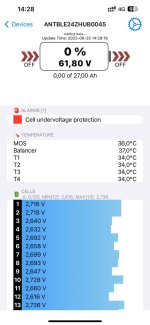Please read your words one more time! Do you think it's normal for the SmartBMS,(I want to note: Smart!!!) block changing when battery is fully discharged? Discharged Li cells of battery will be happy with this?
Yes, if the cells are below the safe-low-voltage charging limit, it *has* to prevent charging, because they are below the limit that the manufacturer / builder has determined is safe to recharge those cells at.
This is because it's potentially unsafe to recharge overdischarged cells, that *could* be damaged in ways that could result in a fire, and it's not possible to tell if they are or aren't until the fire happens. :/ (or you destroy the cells to check them for damage with some form of microscopy)
If the limit has been set correctly, it will only prevent recharging cells that actually have a potential to have been damaged by the voltage they dropped to. The BMS can't know anything about this, it only does what it has been told to do.
If the cells are only below the regular LVC (to stop discharging when empty) and the BMS wont' allow recharge, *then* the BMS is defective or incorreclty designed.

A BMS should have at least two low limits (which may or may not have user-accessible settings to read or to change):
-- The first is the regular LVC, the voltage that if detected at any cell will cause it to turn off the discharge port.
-- The second is the safe-low-voltage limit (whatever the translation happens to be for that in non-technical Chinese/etc), the voltage that if detected at any cell will cause it to turn off *all* ports, to prevent recharge of an overdischarged (potentially hazardously damaged) cell.
Some BMS in OEM packs actually brick the pack if the second limit is detected, so that no user can accidentally start a fire by recharging a pack with damaged cells. (this is why unplugging the BMS from the balance/sense connector can brick it in some OEM bike battery packs, making them difficult to repair without knowing this and taking precautions against it).



